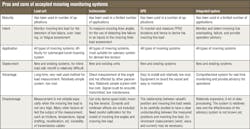Monitoring systems help improve mooring integrity, performance
Suqin Wang
ABS
Corrosion, wear, installation damage, flaws in manufacturing, material incompatibility, and even design errors can lead to degradation and deterioration that impact mooring system functionality and compromise safety. Inspecting deepwater mooring systems is a difficult task, but because these systems are safety-critical, understanding their performance and degradation is essential to safe operations.
Evaluating today’s systems
To date, the vast majority of mooring systems have performed to design specifications, but there have been failures in recent years. Some of those failures have involved multiple mooring lines, resulting in lost stationkeeping; emergency production shutdown; damage to risers; and in some cases, small hydrocarbon leaks. Although none of the recorded incidents resulted in complete failure of the mooring system, the impact on safety and the associated financial consequences were quite high.
The greatest area for potential improvement in mooring system safety is in programs that address mooring integrity management, inspection, and monitoring.
The first step toward improving the way inspections are being done is to understand the monitoring systems in use, taking into account the fact that the effectiveness of these methods depend on the particular characteristics of the mooring system, the environmental conditions on site, and a number of other conditions.
Using load cells is the most straightforward way to detect mooring line failures. Unfortunately, accuracy, reliability, and robustness are major concerns with this approach, especially underwater, where access to the mooring line and instrumentation is extremely limited. Over the long term, power and signal transmission cables deteriorate, and while signal drift can be detected up to a point, it is not always possible to determine what is due to instrument drift and what is the result of a change in the mooring line load. The introduction of in-line load cells housed in protective casing and transmitting data via acoustic transmitter offers improvements to the traditional approach.
Inclinometers offer a way to evaluate system integrity by measuring mooring line angles. If there is a significant change in angle in calm weather conditions, it is quite likely that a line failure could be the cause. For catenary systems, inclinometers can be used to derive an approximation of the mooring line (quasi-static) tension by measuring the angle of the mooring line at or near the top connection to the platform. The drawback is that the dynamic and non-linear effects are not included in the calculated tension from angle.
A third approach is to use a global positioning system that can identify abnormalities in the offset of the floating production system (FPS) to possibly indicate a mooring line failure. The issue with this approach is that it is imprecise and can only indicate that a change has occurred. It can provide a trigger for further inspection, but it is limited in its usefulness on its own.
A fourth alternative is to use an integrated monitoring system in conjunction with a forecast system. The monitoring system can track a range of parameters such as wind, wave and current, FPS motions, mooring line angle and load. The forecast system can include FPS motion and mooring line load predictions. A central server onboard the FPS collects, stores, and processes data from the various instruments. A relatively simple integrated monitoring system installed on an FPSO logs vessel position and mooring line angle measurements, deriving the mean mooring line using the measured mooring line angles and vessel position data. The calculated mooring line tension can be compared to preset thresholds so changes can be identified.
Limitations
The effectiveness of system monitoring is a considerable concern because not every system works on every type of mooring system. Many factors need to be taken into account when a monitoring system is being designed.
First, monitoring objectives have to be defined clearly so the proper analysis tools can be validated and abnormal behavior identified so line failures can be detected. The second critical step is to evaluate mooring system performance under various environmental conditions so there is an acceptable baseline for mooring system performance. Third, it is important to understand the monitoring system itself - its functionality, limitations, and the extent of its reliability.
Real-time mooring monitoring systems can be beneficial to mooring system integrity by revealing anomalies for further investigation, providing line failure warnings, verifying numerical models for mooring strength analysis for improved understanding of the system, assessing fatigue damage. They can also provide information for risk-based inspection, inspection modification, and repair plan development. While progress has been made, with the number of installed monitoring systems increasing and subsequent technical advancements being achieved, their reliability and effectiveness are still limited.
R&D goals
One of the most significant challenges in developing and maintaining mooring monitoring systems is managing costs while monitoring the optimum useful information at the lowest level of investment. In addition to being easy to use, an effective system must gather the information needed to understand performance relative to established baselines using reliable and accurate equipment and to effectively record and process data such that degradation and failures are detectable.
Data processing and management is another area for improvement. The data management system has to accurately store, analyze, interrogate, and trend a very large volume of captured data so appropriate system assessments can be made.
It also is vital to understand gaps in mooring monitoring technology. The lack of the direct link between monitored parameters and specific onboard operations guidelines is likely the reason for insufficient impetus for industry to deploy suitably robust and effective systems.
Finally, it is important to develop better training for operations personnel. Improving operations and failure response procedures will make it easier for personnel to monitor system performance and respond to emergencies.

